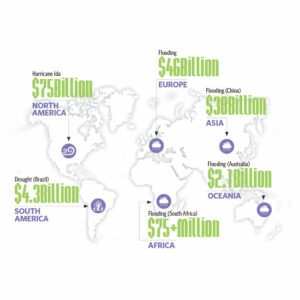Keeping the Power on with Renewable Microgrids
Hospitals can’t lose power. Period. Doctors and patients depend on electricity to run the sensors, monitors, infusion devices and other equipment needed to deliver care and save lives.
Traditionally, hospitals relied on their own microgrids for backup power when outages occurred. A microgrid is a source of electricity that serves a specific local area, such as a hospital, campus or business complex, and can be operated independently from the traditional utility electricity grid.
Most microgrids are powered by diesel generators which emit large amounts of carbon dioxide and more than 40 toxic air contaminants, including known carcinogens. That’s not the healthiest solution, especially for a healthcare provider.
This is why hospitals have been among the earliest adopters of renewable microgrids, which are based on sources such as solar, wind, biofuel and fuel cells, often accompanied by battery storage.
In 2017, healthcare provider Kaiser Permanente integrated a microgrid consisting of 250 kilowatts of solar and a one-megawatt battery system to its existing diesel-powered backup system at its Richmond Medical Center in California. Besides ensuring uninterrupted power to the hospital’s acute-care facility, the microgrid helps Kaiser Permanente maintain the carbon neutral status it achieved in 2020. It’s also projected to save nearly $400,000 annually by lowering the amount of electricity the facility must purchase from the utility.
The need for microgrids is growing as extreme weather events associated with climate change increase the frequency of grid outages that impact business operations. A recent Associated Press analysis of utility data submitted to the U.S. Department of Energy (DOE) found that the annual number of severe weather-related outages have more than doubled since the early 2000s. Across the economy, the DOE estimates that power outages cost businesses $150 billion each year.
Last year, consultancy Wood Mackenize Power and Renewables (WoodMac) reported that 2021 was on track to be a record year for microgrid installations in the U.S. and estimated that 800 megawatts of microgrid projects would be installed by 2024. According to WoodMac, companies that have already installed microgrids include The Home Depot, Whole Foods, GM, Toyota, Stop & Shop and Kaiser Permanente.
Some of these microgrid programs aren’t quite so micro: The JFK airport modernization project, for example, will use microgrids as part of an effort to move the airport to 100 percent renewable energy over the coming decade.
For organizations with lesser needs, the “microgrids as a service,” or MaaS, model offers a more affordable alternative. Microgrid developers are responsible for designing, financing and installing a microgrid at a company’s facility. The company in turn agrees to purchase electricity produced by the microgrid at a set price for a set period of time, usually 25 years, which can help insulate a business from future utility price hikes. Market researcher Knowledge Sourcing Intelligence projects the global MaaS market to grow to $2.6 billion by 2026, from $812.5 million in 2019.
Increasingly frequent power outages take a toll on companies’ financial performance. Yet traditional fossil fuel backup solutions only contribute to climate-change-fueled extreme weather. Renewable microgrids can help companies make progress towards decarbonization goals while also ensuring they stay open and operating at all times.
Executive Mindset
Backup plan:
“Our stores are an important community resource for our customers, particularly when severe weather strikes. Whether customers need to stock up on food, batteries, flashlights, other emergency items, or even
their prescription medications, we know how vital the products and services our stores provide are. [Microgrids] will not only reduce our stores’ impact on the environment but also ensure our stores can stay
open when needed most.” —Gordon Reid, President of Stop & Shop,
in a 2020 announcement about microgrids being installed at 40 of the company’s stores

This article appeared in the Summer 2022 issue of Insigniam Quarterly with the headline “Heat Map: Staying Power.” To begin receiving IQ, go here.



